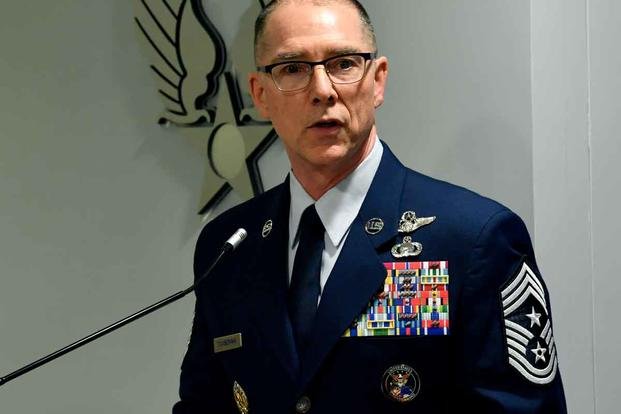When Gen. John W. "Jay" Raymond, Space Force's chief of space operations, approached Air Force Chief Master Sgt. Roger Towberman about crossing over to the new military branch, it wasn't an easy call.
Towberman already had 30 years of service in the Air Force, and space operations was not his area of expertise. But getting to work with Raymond, Towberman says, was what ultimately made the decision for him.
Now, as the Space Force begins to grow and develop, Raymond and Towberman are leading the way on what working in the new service will be like. Towberman sat down with Managing Editor Hope Hodge Seck for Military.com's Podcast, "Left of Boom," to talk about what people need to know about America's newest branch.
1. It's been a long time coming.
Although the Space Force as it exists was conceived and implemented by President Donald Trump, talk of a space-oriented service dates back as far as the Clinton administration.
"I normally start by reminding people that this is a long journey, a two-decade bipartisan journey," Towberman says. "These first conversations happened around the turn of the century. … The reality is that the benign and uncontested and uncongested space environment of the '90s no longer exists."
2. It's not just about active combat in space.
Much of what happens "up there" affects more than just the military forces working toward dominance in Earth orbit. It affects everyone. The Space Force has to be interconnected with friendly commercial operations to ensure life continues as usual for people on terra firma. Everything from automatic teller machines to landline calls run through orbit now.
"When we talk to our allies and partners, a lot of times it's not the Department of Defense or their military departments that are leading the conversation," Towberman notes. "It's their commerce departments, it's their transportation departments, it's their treasury. These are people that are keenly aware of the importance in space."
3. Everyone in the Space Force will help create its culture.
The hodgepodge of troops and officers coming from different services to make up the newest service will all have a hand in creating the sixth military branch's new identity. Members of the Space Force gathered in meetings to discuss their views, and those meetings included everyone from Air Force Academy officers to young two-stripers.
"What can we craft the narrative around? What can we craft an identity around? What is defensible -- not in a 'we're being attacked' way, but in a 'what can we explain well' way," Towberman says. "[What can we] put into doctrine, put into military education? What are we comfortable with that we can say, 'This is us?'"
4. Finding a visible ethos will be difficult -- but it's possible.
Where parts of the military can look to the actions of their branches -- the history and traditions that come with decades, or even centuries, of service -- with pride, the Space Force is too new and perhaps too technical to have similar elements of identity. It will have its own story, but it will take time. But just because the Space Force isn't asking its people to charge a hill with bayonets, doesn't mean there will be no sources of service pride.
"You've got to find your path, you know, through different things. There are some really, really cool Gucci things that we do, you know, behind those doors," Towberman says. "So for the people that get to do it, that's a little bit easier, but for sure, it'll present a recruiting challenge. … We have to remember that our No. 1 priority is to deter conflict."
5. There's a good reason we don't know what members of the Space Force will be called.
An essential element to the identity of a U.S. military service branch is being able to its members airmen, soldiers, sailors, Marines or Coast Guardsmen. It's almost as identifiable as wearing the uniform itself. So a lot has been made (and speculated) about what Space Force members will be called. The service still hasn't decided.
Towberman describes one-way and two-way decisions. A two-way decision is something on which you could change course. A one-way decision is irreversible. Naming the men and women of the Space Force is a one-way decision.
"Once we decide, we're going to live with it," he says. "So it requires us -- and I think we're obligated to our future 'space wallahs,' whatever we call them -- to get this right, because we're gonna hang this moniker on them forever."
6. Space Force members are already in basic training.
The Space Force is actively recruiting and sending its troops to training. Right now, they go through Air Force basic training at Joint Base San Antonio-Lackland, Texas, but they wear Space Force uniforms.
But it could all change, depending on the Space Force's needs.
"I think long term we'll do something probably quite a bit different," Towberman says. "There are definite challenges, though. …. We don't want to attack something that's just good for basic military training; we will always want to attack things that are good for the whole ecosystem."
Be sure to listen to the entire Left of Boom interview with Chief Master Sgt. Roger Towberman, senior enlisted leader of the Space Force, and tune in to new episodes of Military.com's "Left of Boom" podcast on iTunes, Google Podcasts, Spotify, TuneIn and Stitcher.
Follow host Hope Hodge Seck on Twitter @HopeSeck.
-- Blake Stilwell can be reached at blake.stilwell@military.com. He can also be found on Twitter @blakestilwell or on Facebook.
Want to Learn More About Military Life?
Whether you're thinking of joining the military, looking for post-military careers or keeping up with military life and benefits, Military.com has you covered. Subscribe to Military.com to have military news, updates and resources delivered directly to your inbox.

















